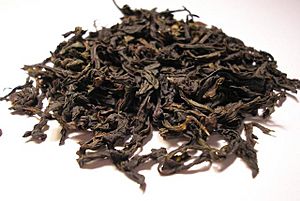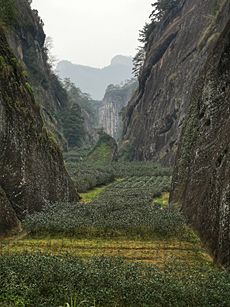Wuyi tea facts for kids
Quick facts for kids Wuyi tea |
|||||||||||
|---|---|---|---|---|---|---|---|---|---|---|---|

Da Hong Pao, a typical Wuyi tea
|
|||||||||||
| Chinese | 武夷茶 | ||||||||||
|
|||||||||||
| Alternative Chinese name | |||||||||||
| Chinese | 武夷岩茶 | ||||||||||
|
|||||||||||
Wuyi tea is a special kind of tea that comes from the Wuyi Mountains in northern Fujian, China. It is also known as Bohea in English. This region is famous for making both black tea and oolong tea. Many well-known teas, like Lapsang souchong and Da Hong Pao, come from here.
The Wuyi Mountains have been a very important place for tea making for a long time. It is believed that both black tea and oolong tea were first made in this area. Wuyi teas are special because of the unique land where they grow. This special land is called "terroir" (say: terr-WAHR). It means the soil, climate, and everything else about the place makes the tea taste unique.
Because the tea bushes grow on mountain slopes, they don't produce as much tea. This makes Wuyi tea quite expensive. Tea from older bushes is even more costly and harder to find. For example, Da Hong Pao tea from its original bushes is one of the most expensive teas in the world. It can be worth more than gold! Most Wuyi tea you can buy today comes from younger plants grown lower down the mountains.
Contents
History of Wuyi Tea
During the Song Dynasty, a large tea farm called Northern Park was the main supplier of tea to the emperors. This farm was located in Fujian. For many years, it sent special "wax tea" cakes to the emperors.
In 1391, the Hongwu Emperor of the Ming dynasty changed things. He said that making wax tea was too much work for people. He ordered that all imperial tea should be loose leaves, not pressed cakes. Because of this, tea production at Northern Park stopped. The main tea-making area in Fujian then moved west to the Wuyi region.
In the 1500s, farmers in Wuyi started growing tea on the mountains. They often grew tea on land owned by Buddhist or Taoist temples. These farmers cut flat steps, called terraces, into the mountain slopes. They also built systems to control water.
How Oolong Tea Was Invented
During the Ming dynasty, monks in another area of China found a new way to make tea. Instead of steaming tea leaves, they cooked them in a dry pan called a wok. This stopped the tea from changing color and flavor too much. This new method made popular green tea.
In the 1500s, tea makers in Wuyi invited these monks to teach them their techniques. The Wuyi tea makers then made an important discovery. They found that if they let the tea leaves change color a little bit before cooking them, they could make a darker, very fragrant tea. This new type of tea became known as oolong tea. The name "oolong" means "black dragon" in Chinese.
Wuyi Tea Goes West
European traders started buying tea in Canton (now Guangzhou) in the 1600s. At first, most of the tea they bought was green tea. But Wuyi was the main place that made darker, more processed teas. So, the name "Bohea" (from the local pronunciation of "Wuyi") became a general name for all darker teas. At that time, people didn't use the words "black" or "oolong" yet.
Over time, people started to tell the difference between dark teas. Lapsang souchong, a Wuyi tea, was sold as "Souchong" for a higher price. The best quality black tea was called "Pekoe." The term "Bohea" then came to mean black tea of lower quality.
In the 1700s, people in Europe started to prefer black tea over green tea. The price of black tea went down, so more people could afford it. Bohea tea was very popular in Europe. When other trading companies started selling cheaper Bohea tea, the Dutch East India Company and the British East India Company also started selling more black tea.
Because Dutch Bohea tea was cheaper, people in Britain's American colonies often bought it illegally. The Tea Act of 1773 was meant to help the British East India Company sell its tea in America. But it led to protests, including the famous Boston Tea Party.
In 1848, a botanist (a plant scientist) from Scotland named Robert Fortune traveled to China. He was working for the British East India Company. His goal was to get tea plants to start a tea industry in India. At that time, foreigners were not allowed to travel far into China. So, Fortune dressed up as a Chinese official. He visited tea-growing areas, including the Wuyi Mountains. He collected tea plants and seeds from Wuyi. He also learned from the monks how to plant, pick, and process tea leaves. He even hired Chinese workers to help with tea production in Darjeeling, India.
Characteristics of Wuyi Tea
Wuyi teas are usually more processed than green teas. They are somewhere between black teas and darker oolong teas. The tea leaves are often twisted into thin strips. They are not rolled into a ball shape like some other oolong teas.
Wuyi teas are often "fired" (cooked) strongly. This gives them a special smoky taste. They can also have flavors like stone fruit (like peaches or plums).
Famous Wuyi Teas
- Da Hong Pao ('Big Red Robe')
- Rou Gui ('Cinnamon Scent')
- Lapsang souchong
- Tieluohan ('Iron Arhat')
- Bai Jiguan ('White Cockscomb')
- Shui Jin Gui ('Golden Water Turtle')
- Qilan ('Rare Orchid')
- Jin Jun Mei ('Golden Horse Eyebrow')


